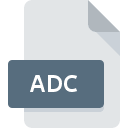.ADC File Extension

Scanstudio 16 Color Image
| Developer | Steffen Gutmann |
| Popularity | |
| Category | Raster Image Files |
| Format | .ADC |
| Cross Platform | Update Soon |
What is an ADC file?
ADC files, bearing the extension “.ADC”, are primarily associated with Scanstudio 16 Color Image files. These files are utilized in various applications for storing color images, particularly those created or manipulated using Scanstudio software.
The ADC file format serves as a container for high-resolution color images, often used in scientific imaging, microscopy, and other fields requiring detailed visual data.
More Information.
ADC files were first introduced as part of the Scanstudio suite, a comprehensive software solution tailored for capturing and analyzing images from various scientific instruments like microscopes and scanners.
The primary purpose was to offer researchers and analysts a standardized format for storing color-rich images with minimal loss of detail and fidelity.
Over time, their usage expanded beyond scientific applications into fields such as industrial imaging and digital arts where precise color reproduction is critical.
Origin Of This File.
The development of ADC files traces back to the need for efficient storage and retrieval of high-quality color images.
Initially conceived for use with Scanstudio software, these files became integral in the realm of digital imaging and scientific visualization.
The format was designed to accommodate the specific requirements of capturing and preserving detailed color data essential for analytical and presentation purposes.
File Structure Technical Specification.
The structure of ADC files is designed to maintain high fidelity and resolution while efficiently storing color data. Key technical specifications include:
- Image Data: ADC files store pixel data in a structured format, often employing raster graphics principles to arrange color information.
- Color Depth: These files typically support various color depths, including 24-bit true color, ensuring accurate representation of hues and shades.
- Compression: To optimize storage space, ADC files may employ lossless compression techniques like Run-Length Encoding (RLE), balancing file size with image quality.
How to Convert the File?
Converting ADC files may be necessary to enhance compatibility or modify images for different purposes. Several methods can achieve this:
- Conversion Software: Dedicated software tools like Adobe Photoshop, GIMP, or specialized scientific imaging software can convert ADC files to more common formats like JPEG or PNG.
- Online Converters: Web-based converters offer a convenient solution for converting ADC files to widely supported formats accessible across various devices.
Advantages And Disadvantages.
Advantages:
- High Fidelity: ADC files preserve image quality, making them suitable for detailed scientific analysis and professional imaging.
- Versatility: Compatible with various software tools and platforms, enhancing their utility in diverse applications.
- Compression Efficiency: Effective compression algorithms reduce file size without compromising image quality.
Disadvantages:
- Compatibility Issues: Older versions of software may not fully support newer ADC file features.
- Complexity in Handling: Requires specific software to create and manipulate ADC files, limiting ease of use for casual users.
- File Size: Despite compression, ADC files can be large due to high-resolution color data, posing challenges for storage and transmission.
How to Open ADC?
Open In Windows
- Use applications like Adobe Photoshop, CorelDRAW, or ImageJ to open ADC files.
Open In Linux
- Software such as GIMP, ImageJ, or scientific imaging tools available for Linux can handle ADC files effectively.
Open In MAC
- Adobe Photoshop, GIMP, and Preview are suitable for viewing and editing ADC files.








